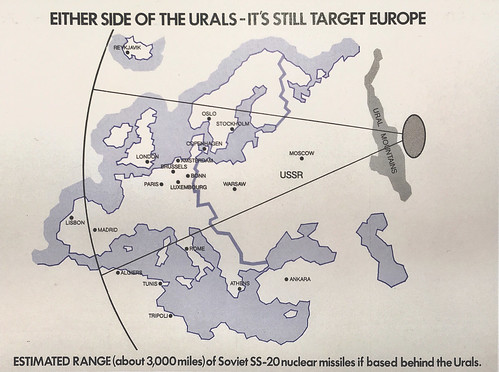Friday, 8:59am
13 December 2019
Walking in a nuclear winter land
A new book recalls a time when civil authorities urged citizens to prepare for a threat from the East. By Andrew Robertson

The book Nuclear War in the UK, already in its second printing, has been a surprise hit of the Christmas election season, writes Andrew Robertson.
It is the seventh title in the publisher’s ‘Irregulars’ series of books that present ‘a visual history of modern British culture’. (John O’Reilly reviewed Eyeball Cards, the first in the series, in Eye 95.)
The slim hardback, written by Taras Young and designed by John Morgan Studio (see Eye 83), is a sober account of the various print campaigns commissioned by Civil Defence authorities and the Central Office of Information (COI) to prepare UK citizens for the consequences of nuclear war.
Target Europe. Map from early civil defence materials showing the reach of Soviet nuclear missiles.
Top. Spread from Nuclear War in the UK showing a training poster that depicted a typical British high street, with cafés, shops and banks, after a nuclear attack.

The period covered stretches from the late 1940s – when the atom bomb attacks on Hiroshima and Nagasaki were still fresh in the memory – until the 1980s, when the infamous Protect and Survive booklet was published widely (attracting derision and parody) and the subsequent thawing of East-West relations.
Run for the bunker. Spread from Nuclear War in the UK by Taras Young. Design: John Morgan Studio, 2019.

The fascinating collection of printed artefacts also includes non-official curiosities such as the magazine Protect & Survive Monthly, with its sensible-looking cover girls and dodgy adverts for fall out shelters and bunkers. A full-page ad from a short-lived company called Rusepalm promised ‘one of the deepest and safest shelters ever seen in the United Kingdom’ with prices starting at £2000 for a lease of up to 99 years.
The key word is survival. Cover of Protect & Survive Monthly, November 1981.

Taras Young’s straightforward text details some of the initiatives, discussions and disagreement that lay behind the production of these materials, and the regional variations that led to leaflets such as Bristol & The Bomb and Hull and the Bomb, which now look more like club flyers than official documents.
Regional variations on a mushroom cloud, 1983-84. Author Taras Young writes: ‘Councils on the right of the political spectrum were enthusiastic authors of war books.’

Some local authorities, notably the left-wing GLC (Greater London Council), refused to join in the gloomy business, arguing that the preparations gave a false sense of security.
Health warning. Example of material produced by the left-wing GLC’s Nuclear Policy Unit, whose stance was at odds with that of the Tory government, 1985.

Cover of Nuclear War in the UK, which shows a page from the training scheme materials prepared for the Royal Observer Corps (ROC), 1989. Young writes: ‘the bulk of the ROC’s activity was ended as the Cold War drew to a close in 1991.’

The story ends not with a bang, but a whimper. Young writes that such didactic leaflets and posters belong to another age, and that the ‘public humiliation of Protect and Survive had a lasting effect’. As the Cold War came to an end, government bodies opted for more low-key methods.
Spread inside front cover. Design by John Morgan Studio.

However the graphic style of Nuclear War in the UK lives on – in dystopian science fiction, TV comedy and the painstaking pastiche of Richard Littler’s Scarfolk Annual, which may explain the book’s success in dark times. And an early COI leaflet beats anything dreamed up by a contemporary satirist: against a background of ruined buildings, an infant girl looks up at a uniformed woman. The text reads: ‘Today willingness to help is not enough. Be able to help JOIN CIVIL DEFENCE.’
Andrew Robertson, writer, London
Eye is the world’s most beautiful and collectable graphic design journal, published for professional designers, students and anyone interested in critical, informed writing about graphic design and visual culture. It is available from all good design bookshops and online at the Eye shop, where you can buy subscriptions and single issues.
